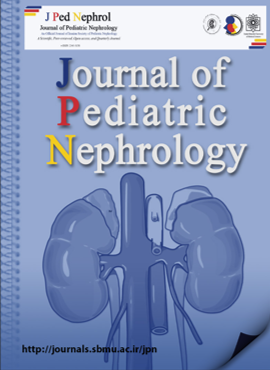A Hospital Based Cross-Sectional Study to Evaluate the Spectrum of Congenital Anomalies of Kidney and Urinary Tract, and Clinico-Epidemiological Characteristics
Journal of Pediatric Nephrology,
Vol. 7 No. 4 (2019),
29 December 2019
,
Page 1-8
https://doi.org/10.22037/jpn.v7i4.27406
Abstract
Background and Aim: To determine the spectrum of congenital anomalies of kidney and urinary tract (CAKUT) in Indian children, and to evaluate its clinico-epidemiological characteristics.
Methods: A tertiary-care, hospital-based cross-sectional study conducted (November 2016-October 2018) at SCBMCH & SVPPGIP Hospital included children aged ≤14 years with a diagnosis of CAKUT. Incidence of individual congenital anomalies and clinico-epidemiological characteristics of each anomaly thus considered were evaluated.
Results: In 140 children, 9 types of congenital anomalies were reported; posterior urethral valve was most common (37.85%) followed by pelvi-ureteric junction obstruction (32.14%) and vesico-ureteric reflux (14.28%). Hypospadiasis (5%), renal agenesis (2.86%), multicystic kidney disease (2.86%), duplication of pelvi-calyceal system (2.14%), horseshoe kidney (1.42%) and ureterocele (1.42%) were other CAKUTs. A total of 68.57% were boys (girls=31.43%). The CAKUTs were observed more in children with: age 1-5 years (32.14%), unilateral disease (45%), and term delivery (67.86%), and in children of mother aged >30 years (58.57%). Diabetes was present in mothers of 4 children (gestational: 2, pre-gestational: 2), hypertension in 3, tobacco use in 5, oligohydramnios in 7 and polyhydramnios in 3 mothers. Majority of the children had asymptomatic (37.86%) manifestation followed by burning micturition (31.43%). Non-renal congenital anomalies were present in 15.71% children (gastrointestinal malformations: 5.71% were most common). Positive family history for CAKUT was seen in 7.8% cases.
Conclusion: The most frequent CAKUTs were posterior urethral valve and pelvi-ureteric junction obstruction in our study. The study also provided the clinico-epidemiological characteristics of CAKUT. These data can be helpful for prenatal counseling and management of CAKUTs.
Keywords: CAKUT; congenital anomalies; child; Indian.
- CAKUT
- congenital anomalies
- children
- Indian
How to Cite
References
DeSilva M, Munoz FM, McMillan M, Kawai AT, Marshall H, Macartney KK, et al. Congenital anomalies: Case definition and guidelines for data collection, analysis, and presentation of immunization safety data. Vaccine. 2016;34:6015-26.
Vatankhah S, Jalilvand M, Sarkhosh S, Azarmi M, Mohseni M. Prevalence of Congenital Anomalies in Iran: A Review Article. Iranian journal of public health. 2017;46:733-43.
Kumar BH, Krishnamurthy S, Chandrasekaran V, Jindal B, Ananthakrishnan R. Clinical Spectrum of Congenital Anomalies of Kidney and Urinary Tract in Children. Indian Pediatrics. 2019;56:566-70.
Rosenblum ND. Overview of congenital anomalies of the kidney and urinary tract (CAKUT). Waltham (MA): UpToDate. Available at: http://www. uptodate. com/contents/overview-of-congenital-anomalies-of-the-kidney-and-urinary-tract-cakut. Retrieved July. 2015;17.
Radhakrishna V, Kumaravel S, Priyamvada P, Hanumanthappa N, Jindal B, Govindarajan K, et al. Clinico-Biochemical Profile of Children with Congenital Anomalies of the Kidney and Urinary Tract: A Cross-Sectional Study. Kidney Diseases. 2019;5:51-7.
Li Z-y, Chen Y-m, Qiu L-q, Chen D-q, Hu C-g, Xu J-y, et al. Prevalence, types, and malformations in congenital anomalies of the kidney and urinary tract in newborns: a retrospective hospital-based study. Italian journal of pediatrics. 2019;45:50.
Shnorhavorian M, Bittner R, Wright JL, Schwartz SM. Maternal risk factors for congenital urinary anomalies: results of a population-based case-control study. Urology. 2011;78:1156-61.
Karambelkar GR, Malwade SD, Agarkhedkar S, Singh A, Salunkhe SR, Saini N. CONGENITAL RENAL AND URINARY TRACT ANOMALIES IN SELECTED NEONATES. J. Evid. Based Med. Healthc. 2016;3:1152-7.
BASAR H, BASAR R, BASAR MM, ERBIL M. The comparison of the incidence of horseshoe kidney in autopsy cases versus urologic patient population. Okajimas folia anatomica Japonica. 1999;76:137-139.
Soliman NA, Ali RI, Ghobrial EE, Habib EI, Ziada AM. Pattern of clinical presentation of congenital anomalies of the kidney and urinary tract among infants and children. Nephrology. 2015;20:413-8.
Melo BF, Aguiar MB, Bouzada MC, Aguiar RL, Pereira AK, Paixao GM, et al. Early risk factors for neonatal mortality in CAKUT: analysis of 524 affected newborns. Pediatr Nephrol. 2012;27:965-72.
Tain YL, Luh H, Lin CY, Hsu CN. Incidence and Risks of Congenital Anomalies of Kidney and Urinary Tract in Newborns: A Population-Based Case-Control Study in Taiwan. Medicine (Baltimore). 2016;95:e2659.
Postoev VA, Grjibovski AM, Kovalenko AA, Anda EE, Nieboer E, Odland JO. Congenital anomalies of the kidney and the urinary tract: A murmansk county birth registry study. Birth Defects Res A Clin Mol Teratol. 2016;106:185-93.
Shnorhavorian M, Bittner R, Wright JL, Schwartz SM. Maternal risk factors for congenital urinary anomalies: results of a population-based case-control study. Urology. 2011;78:1156-61.
Barutta F, Bruno G, Mastrocola R, Bellini S, Gruden G. The role of cannabinoid signaling in acute and chronic kidney diseases. Kidney Int. 2018;94:252-8.
National Academies of Sciences, Engineering, and Medicine, National Academies of Sciences, Engineering, and Medicine. Health and Medicine Division, Board on Population Health and Public Health Practice, Committee on the Health Effects of Marijuana: an evidence review and research agenda. The health effects of cannabis and cannabinoids: the current state of evidence and recommendations for research. The health effects of cannabis and cannabinoids: The current state of evidence and recommendations for research. 2017.
Bondagji NS. Antenatal diagnosis, prevalence and outcome of congenital anomalies of the kidney and urinary tract in Saudi Arabia. Urol Ann. 2014;6:36-40.
- Abstract Viewed: 325 times
- PDF Downloaded: 185 times

